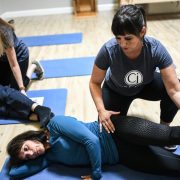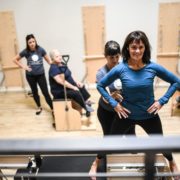Avoid Pills. Use Movement as Medicine Instead
Avoid Pills. Use Movement as Medicine Instead
In the 1990’s, it started becoming widely accepted to prescribe opioids for people recovering from surgery or injury. As well as those suffering with moderate-to-severe musculoskeletal pain (such as back pain and osteoarthritis). Although effective for managing pain, we would soon find out how highly addictive these drugs are. Statistics show that one in four patients receiving long-term opioid therapy in a primary care setting struggles with opioid addiction. And once addicted, it’s very hard to stop. Keep reading to lear why movement as medicine is a better option.
The Centers for Disease Control and Prevention (CDC) found in their 2018 Annual Survey Report of Drug-Related Risks and Outcomes that in 2016, more than 11.5 million Americans reported misusing prescription opioids. And despite efforts to curb these statistics, this number started to creep up again during the pandemic.
In response, the medical community established more strict control around the prescription of opioids. Many are avoiding prescribing them all together. For patients with severe back pain and arthritis, for example, injections and minor procedures have become far more common and recommended.
While this approach prevents you from becoming addicted to opioids, there are still inherent risks any time you have an injection or undergo a procedure.
So what’s the alternative?
Prescriptive movement strategies are the alternative. Specialized, custom-fit “exercises” that are designed to have a very specific (and noticeable) effect on your pain.
But what’s the difference between generalized exercises that make you feel good vs prescriptive movements that also make you feel good?
Well, the distinguishing factor is both in:
1) how your pain responds to the movement while you’re doing it, and more importantly
2) how it behaves afterward. Lots of exercises feel good while doing them, but not all exercises give you the long-lasting effect you’re truly looking for.
For example, let’s say you’ve got back pain. Perhaps stretching your back a certain way makes you feel good and temporarily eases your pain. But an hour or two later, or the moment you perform an activity that typically aggravates your back, your pain comes right back. The stretch makes you feel better, but it doesn’t do a good enough job to make you stay better.
Over time, you might find that your back pain comes and goes often. Although this stretch always helps, nothing really takes away your problem completely. Instead, you get stuck in that vicious cycle of stopping all activities every time you hurt your back. Or worse – start avoiding certain activities altogether for fear of hurting your back. This is no way to live and it’s not an example of a good prescriptive movement strategy.
So what would a prescriptive movement as medicine strategy look like?
Let’s take the same example above. But this time – you find that a particular stretch not only makes your back pain go away in the moment, but it stays gone the more you do it. Whenever your back pain returns, you can reliably use this stretch to take your back pain away every time. This is an example of a prescriptive movement strategy. You know exactly what to do, how often to do it, when to do it. And it works without fail every time. Plus, once you know what your prescriptive movement is, you can use it to prevent pain as well.
The good news is that 70-80% of all musculoskeletal pain responds to a prescriptive movement strategy. It works in all joints and muscles. You just have to work with someone who knows how to help you find it and then use it over the course of time. I can’t tell you how often I meet people who have the right movement, they just weren’t applying it correctly to get the long-term relief they were looking for.
Too good to be true?
It’s not – I promise. The problem is there’s a lot of mis-information out there and not every health care or fitness professional is trained in discovering the prescriptive movement that you need – or teaching you how to use it properly. The second problem – to be frank – is that hospitals make a lot of money from procedures and surgeries. There’s no real incentive for them to support conservative, natural treatments that you can do on your own at home.
With procedures and surgery, the results are faster, which makes for happier patients (in the short term). But studies show that 2-3 years out from surgery your results are no better or worse than if you were properly prescribed movement as your treatment. And after 10 years, those who’ve managed to avoid surgery for the same problem, actually have much better outcomes than those who went under the knife.
The greatest benefit of taking the time to go slow at first, and find a prescriptive movement strategy that works, is that you’ll have this movement “medicine” at your disposal at all times. It’s always in your “medicine cabinet” and you never need a prescription or pharmacy to refill it.
Hopefully I’ve got you thinking. And encouraged you, at the very least, to explore whether or not movement really can be your medicine. If you’re already tried and failed at this, it’s quite possible you just didn’t have the right approach.
Consider talking to someone from my team if you’re serious about getting help.
We’re trained to help you find YOUR prescriptive movement as medicine strategy and are up to date on the latest research.
CLICK HERE to request a Free Discovery Call with my team to see if you’re a good fit for what we do.
Dr. Carrie Jose, Physical Therapist and Pilates expert, owns CJ Physical Therapy & Pilates in Portsmouth and writes for Seacoast Media Group. To request a free copy of her guide to back pain CLICK HERE or to get in touch, email her at [email protected].










